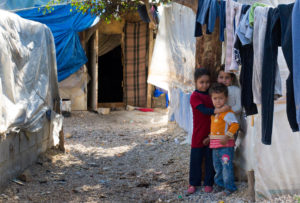Spotlighting the Refugee Crisis in Ai Weiwei’s Human Flow
Posted in: Life in the Middle East


Children and their families end up in makeshift tents in Lebanon refugee camp after fleeing Syria conflict.
There’s an expression in Arabic, khallyh yballt albahar, which translates to, “let him lay tiles on the seafloor,” and is usually said when someone insists on going through with a bad idea they’ve been warned against. I thought of the phrase as I sat down to watch Ai Weiwei’s new film, Human Flow. In it, he travels to 23 countries to acquaint the audience with nearly all of the world’s major refugee crises.
When I heard the film description before the screening, I was skeptical. Crises? Meaning all of them? Broad strokes and narrow details, all in one film? Even at a two hour and twenty minute run-time, I was certain that this would end up being a tile in the sea. I’m glad to report how wrong I was.
At Anera, supporters and casual observers often ask questions along similar lines: who do we serve exactly, or who do we basically work with? The global refugee story is difficult to tell, and if you ask for something basic, you’re likely not going to get something accurate, and vice versa.
Common Threads Among Refugees
There are people suffering from acute displacement, like Syrians or the Rohingya, who are currently on the move and struggling to find any kind of escape from violence. Other refugees face a chronic crisis: Palestinians in Jordan, Palestine, and Lebanon live in camps initially built to last a season, which have instead stood and grown for generations.
Ai’s film isn’t easy to watch, but it’s powerful and at points breathtaking. The camera work is varied and eclectic. The broader shots are landscapes or drone flyovers, which capture in one glance the titanic number of refugees trekking to safety, exposed to biting winters and blazing summers.
Ai Weiwei is not a naïve artist stumbling through an overly ambitious project. He’s not an expert on Gazan politics or Kenyan history, and he isn’t interested in the economics of why one European state can open its borders while another builds a fence. He is a witness, and he plunges the audience deep into the messy, overwhelming story of 65 million desperate and courageous displaced souls crossing continents and oceans to find a safe place to sleep at night.
Leaving the film, I was struck by the commonalities between refugees. Even though they come from different continents, speak different languages, and cross borders by different means, they all live in the same unstable conditions after risking their lives to flee their homes. They all face the same challenges in finding asylum in often unwelcoming places. They all travel lightly, having left everything behind. It’s a reminder that this crisis is global and not limited to a particular war or conflict. And not only do refugees have much in common with one another, but so do we have much in common with them. It’s a common thread of humanity that binds us together.
WATCH: Ai Weiwei’s Human Flow
OUR BLOG
Related
Joint Statement 200+ NGOs call for immediate action to end the deadly Israeli distribution scheme (including the so-called Gaza Humanitarian Foundation) in Gaza, revert to the existing UN-led coordination mechanisms, and lift the Israeli government’s blockade on aid and commercial…
